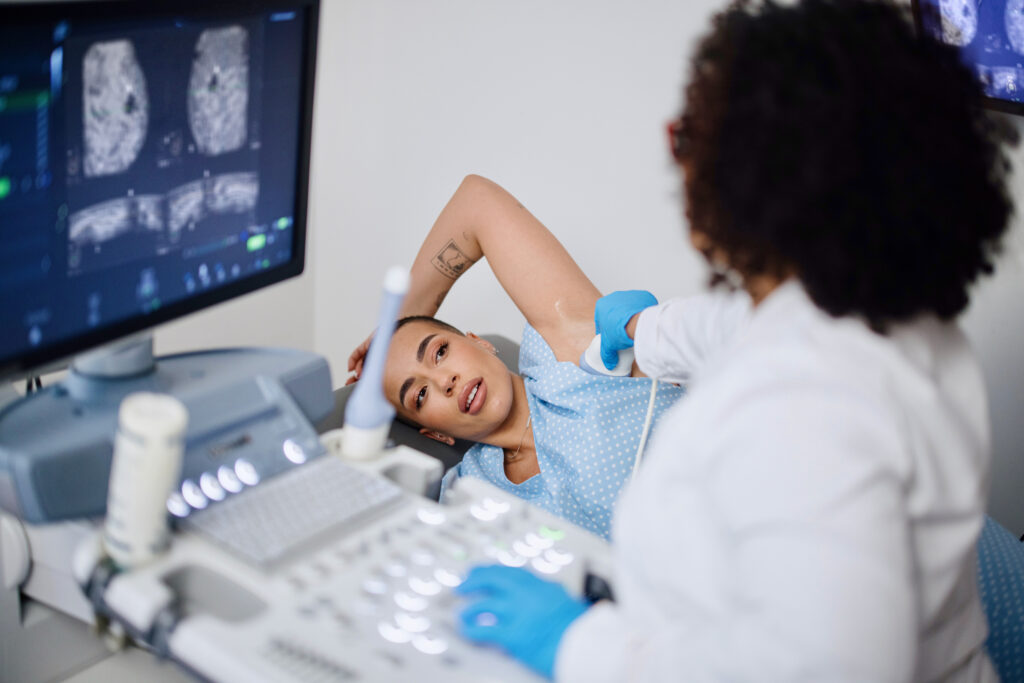
Are you interested in becoming an ultrasound technician? Why do doctors request ultrasounds, and what do they help diagnose? These questions and more will be covered in this article. First, let’s look into what an ultrasound is.
What is an Ultrasound?
An ultrasound is a non-invasive view of the inside of the body. The ultrasound monitor relays images of the soft tissues inside the patient’s body. The ultrasound transmits high-frequency sound waves that bounce off of internal body systems. Then, the transducer sends sound waves back to the ultrasound machine. The sound waves are converted into images that a doctor can use to make diagnosis and treatment decisions.
What Does an Ultrasound Technician Do?
An ultrasound technician, a diagnostic medical sonographer, obtains images of patients’ internal organs using ultrasonic imaging. According to the U.S. Bureau of Labor Statistics, ultrasound technicians operate special imaging equipment to create images or conduct tests. The images and test results help physicians assess and diagnose medical conditions.
The primary responsibilities of an ultrasound technician include the following:
Patient Preparation
The ultrasound technician helps the patient position so that they may access the part of the body that needs to be imaged with an ultrasound. They may drape the patient to help them feel more comfortable. The ultrasound technician also gives an initial overview of what will happen during the ultrasound to put their mind at ease.
Answer Questions About the Procedure
Patients often have questions about the ultrasound. Will it hurt? How long is the process? The ultrasound technician will answer these questions before starting the ultrasound.
Take a Patient’s Medical History
Understanding the patient’s medical history before performing the ultrasound is essential. Does the patient have any issues that can complicate the procedure, like easy bleeding or fainting that may complicate the procedure? Also, abnormalities may be present that can only be identified if the ultrasound technician knows more about the patient’s medical history.
Conducting Ultrasound
The ultrasound technician will start by placing ultrasound gel on the body to minimize the friction of the transducer. The gel can be cold, so the patient must be prepared before applying it. The ultrasound can take up to 30 minutes to complete.
Image Analysis
After the ultrasound, the technician reviews the images to ensure there are no abnormalities. If there is an emergency, they will contact the doctor immediately. The doctor may request additional ultrasound images if the images are unclear or have artifacts.
Equipment Calibration and Maintenance
A properly calibrated and maintained ultrasound is crucial to the success of the imaging process. An ultrasound technician will review the equipment, clean and sanitize it for each patient, and review the proper maintenance schedule to return the best images possible.
Record Findings and Manage Patients’ Electronic Records
Images are recorded in the patient’s electronic health records so that physicians and future medical professionals can refer to them as they make diagnoses and treatment decisions. Comparing historical images to current images can also help identify any abnormalities.
What Do Ultrasounds Help Diagnose?
Ultrasound helps doctors create a treatment plan for any ailments or diseases. Ultrasounds are a non-invasive way to view organs, blood vessels, and soft tissue. Ultrasounds are used to diagnose many conditions, like monitoring the growth of a fetus. Some of the things an ultrasound helps diagnose include:
Abdominal Pain
An ultrasound can help diagnose the sources of abdominal pain. This can include imaging organs in the abdomen, such as the liver, pancreas, spleen, and gallbladder. These images can diagnose some types of cancer or inflammation of specific structures. Further conditions ultrasound can help diagnose include gallstones, liver disease, pancreatitis, enlarged spleen, fatty liver disease, and abdominal cysts and tumors.
Kidney Abnormalities
An ultrasound can help identify kidney stones, infections, blockages, tumors and cysts, abscesses, disease, and hydronephrosis, a urine buildup in the kidney, among other common diagnoses.
Blood Flow
Ultrasounds image the blood flow in the arteries and veins of the neck, arms, and legs. They can help diagnose blood clots, carotid artery disease, peripheral artery disease, vascular disease, deep vein thrombosis, varicose veins, and extracranial carotid artery aneurysm, which can lead to a stroke if not treated.
Pelvic Cancers & Disease
For some patients, an ultrasound can diagnose bladder cancer and hernias. For females specifically, it can also help diagnose endometriosis, gynecologic tumors, ovarian cysts, ovarian torsion, pelvic inflammatory disease, pelvic organ prolapse, polycystic ovary syndrome (PCOS), and uterine fibroids. In males, it may help diagnose prostate cancer, testicular cancer, testicular or scrotal infections, and scrotal or penile injuries.
Monitor the Health of a Fetus
Ultrasounds are most associated with the images of a fetus. During a pregnancy, an ultrasound can help the doctor identify if there are any abnormalities and the gender of the baby.
Abnormal Growths
Patients with lumps under the skin can get an ultrasound to identify if they have cancer or a non-cancerous cyst before a skin biopsy is performed. Plus, an ultrasound can supplement a mammogram if there are abnormalities in the breasts.
Reproduction Issues
An ultrasound can focus on the fallopian tubes, ovaries, and vagina or prostate. It can also help diagnose gynecologic tumors, ovarian cysts, ovarian torsion, pelvic inflammatory disease, and an egg outside of the fallopian tubes.
Who Performs Diagnostic Ultrasounds?
Ultrasound technicians perform diagnostic ultrasounds. The radiologist reviews the images and delivers them to the patient’s physician. The medical team discusses the images and creates a treatment plan based on the diagnosis inferred from the images.
Want to Learn More?
Are you fascinated by the advances in 21st-century medicine that allow your health providers to see real-time pictures of blood flow in your arteries or watch a baby move? Enroll in Meridian College’s Diagnostic Medical Ultrasound Associate Degree program and get the training you need for a rewarding new career as an ultrasound technician.
Contact Meridian College today to learn more about becoming a diagnostic medical sonographer.